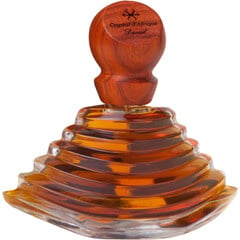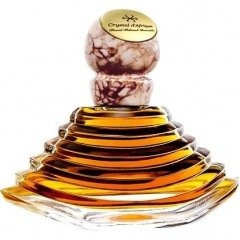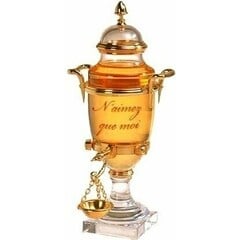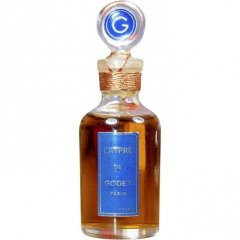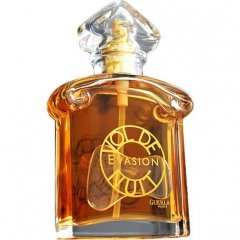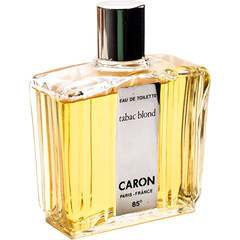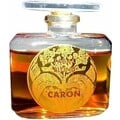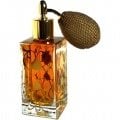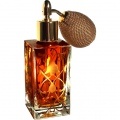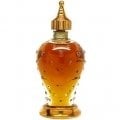
Trollo
Reviews
Translated
Show original
The little sister of the African crystal - EdT vs. EdP
Madegasque ginger begins brilliantly in the eau de toilette as in the eau de parfum and remains clearly perceptible until the deep drydown. Initially accompanied by citric elements, the heart note then becomes very present with an incredible abundance of flowers. Where jasmine appears as a peripheral figure in this fragrance, mimosa can add significant sweetness and neroli freshens up the ensemble. The base already comes through, and as the heart note fades, the base becomes increasingly clear. The bourbon vanilla is of natural origin and of very high quality, not sweet, but noble, yet very present. This may be the effect of the "green" vanilla, which I have never noticed in this form in any other fragrance. A balsamic sweetness is built up by the smoky myrrh. Cedar and frankincense complement the not-too-sweet and resinous-spicy woodiness of the vanilla base. This wonderful and exquisite drydown accompanies you throughout the day.
Like its big sister, the EdP, the bottle is made of heavy crystal and was also produced by hand. Despite its weight and size, it feels very graceful and pleasant. The shape of the eau de toilette bottle is also reminiscent of the sand dunes of African deserts. The round cap is made from hand-carved and polished padouk wood.
Like the EdP, the EdT was created by the French designer with North African roots, David Thibaud-Bourahla, together with Clémentine Humeau. Only sustainably processed, natural ingredients are used, as far as possible from Africa itself. You can feel and smell the quality of the ingredients. Nevertheless, it is of French sophistication and the ingredients are not only of high quality, but also very well interwoven.
The notes themselves hardly differ between the eau de toilette and the eau de parfum I described earlier. The eau de toilette corresponds completely to the eau de parfum in terms of quality and progression. The difference in the fragrance itself lies in the concentration, especially in the silage and the sequence of notes: The EdP is highly concentrated and more of an extrait than an eau de parfum. Even a single spray is already too much for me and the eau de parfum is therefore hardly wearable for everyday use. The eau de toilette can be better dosed. The sequence of top, heart and base notes is somewhat quicker with the eau de toilette and the dreamy base note still lasts all day, but not until almost the next day as with the eau de parfum.
The bottle of the eau de toilette differs in the material of the lid: Where the eau de parfum has cool and heavy marble with a gold plate to offer as a cap, the eau de toilette has a plain wooden cap. Unlike the eau de parfum, the eau de toilette does not have a wooden frame to adjust/display the cap. Of course, there is a certain "something" about holding a heavy and cool marble sphere in your hand. At the same time, however, using the additional wooden frame of the eau de parfum for its complete, very aesthetic presentation is quite complex, as the bottle has to be placed at the right angle in the almost too well-fitting frame.
So if you don't just display the fragrance but also use it regularly, can do without marble as a cap and appreciate a very good but not room-filling silage, perhaps even appreciate the spicy vanilla base more than the top and heart messenger, which builds up more quickly, you are certainly very well advised to go for the eau de toilette, which is considerably cheaper than the eau de parfum.
Like its big sister, the EdP, the bottle is made of heavy crystal and was also produced by hand. Despite its weight and size, it feels very graceful and pleasant. The shape of the eau de toilette bottle is also reminiscent of the sand dunes of African deserts. The round cap is made from hand-carved and polished padouk wood.
Like the EdP, the EdT was created by the French designer with North African roots, David Thibaud-Bourahla, together with Clémentine Humeau. Only sustainably processed, natural ingredients are used, as far as possible from Africa itself. You can feel and smell the quality of the ingredients. Nevertheless, it is of French sophistication and the ingredients are not only of high quality, but also very well interwoven.
The notes themselves hardly differ between the eau de toilette and the eau de parfum I described earlier. The eau de toilette corresponds completely to the eau de parfum in terms of quality and progression. The difference in the fragrance itself lies in the concentration, especially in the silage and the sequence of notes: The EdP is highly concentrated and more of an extrait than an eau de parfum. Even a single spray is already too much for me and the eau de parfum is therefore hardly wearable for everyday use. The eau de toilette can be better dosed. The sequence of top, heart and base notes is somewhat quicker with the eau de toilette and the dreamy base note still lasts all day, but not until almost the next day as with the eau de parfum.
The bottle of the eau de toilette differs in the material of the lid: Where the eau de parfum has cool and heavy marble with a gold plate to offer as a cap, the eau de toilette has a plain wooden cap. Unlike the eau de parfum, the eau de toilette does not have a wooden frame to adjust/display the cap. Of course, there is a certain "something" about holding a heavy and cool marble sphere in your hand. At the same time, however, using the additional wooden frame of the eau de parfum for its complete, very aesthetic presentation is quite complex, as the bottle has to be placed at the right angle in the almost too well-fitting frame.
So if you don't just display the fragrance but also use it regularly, can do without marble as a cap and appreciate a very good but not room-filling silage, perhaps even appreciate the spicy vanilla base more than the top and heart messenger, which builds up more quickly, you are certainly very well advised to go for the eau de toilette, which is considerably cheaper than the eau de parfum.
8 Comments
Translated
Show original
Shimmering light, gravitational beauty - the crystal from Africa
Many perfumes have a story, only a few tell a story. Crystal d'Afrique takes the inclined tester even in this story, on an olfactory journey through Africa.
A journey without words
Madegassic ginger receives the fragrance traveler with full power and accompanies him until the end deep in the night, the whole fragrance pyramid through. To start with, some citric aspects are perceptible, bergamot presumably. A desert storm of flowers from various parts of Africa follows on its heels. The floral abundance of Africa is overwhelming and very well interwoven, I can hardly make out individual notes. A slight sweetness is probably brought by the mimosa and I can perceive neroli, which is probably also responsible for the slightly "green" facet. Is that jasmine singing in the background, for once not playing first fiddle? These first impressions of a continent are so varied, but it does not stop there, the traveler is assailed with further impressions.
The base notes show up in the background of the floral storm, blurred and restrained at first, then permeating it with successive increases as the storm subsides: Spicy woodiness of the mighty cedar of the Atlas Mountains rises from the base with soft, balsamic warm myrrh, increasingly permeating the fragrance. Nature, history and culture are one in this continent. Beguiling bourbon vanilla mingles cautiously underneath, and for a while extremely dominant resinous-aromatic incense lets the traveler dive into the millennia-old history of this continent with its important empires of earlier times, lets him experience the deeply sacred aspects of African tradition and history, which have shaped this continent until today.
These awe-inspiring impressions keeps the sensual drydown for many hours: noblest bourbon vanilla surrounds itself with gifts of the three kings, frankincense and myrrh, framed by a hint of ginger - to the sensation this is the real "Angelique Encens", or perhaps even better - "Encens Vanille Ange".
Tactile beauty - the bottle
The hand-flattering flacon is made of heavy crystal and was created by hand. Its shape is said to be reminiscent of the sand dunes of African deserts. The round cap is made of Moroccan marble, which has been polished by hand. The flacon stands in a finger-galvanized frame made of handcrafted padouk wood, in which a padded round recess in the lid provides a stable stand without damaging the marble closure or even the engraving plate, which, like the engraving plate on the frame, has a 24-carat gold plating.
The feminine soul of Africa
Crystal d'Afrique is not just a trip to Africa, however. The fragrance was created by a French designer with North African roots. For Crystal d'Afrique, David Thibaud-Bourahla and Clémentine Humeau use only sustainably processed natural ingredients, as far as possible from Africa itself. The quality of the ingredients distinguishes the fragrance throughout, and yet, as an African natural perfume, it has the sophistication of a French perfume.
Symbol of the house Thibaud-Bourahla is an ancient symbol of the Berbers, which stands for femininity, patience and harmony, were with this people but in pre-Islamic times the women of great importance in and for society. So I see this fragrance more on a woman. Crystal d'Afrique is an exceptional fragrance, it allows a glimpse into the deeply feminine soul of a continent. Before my inner eye appears the image of a continent with incredibly many facets, fascinating history, cultural significance, respect-inspiring landscape and exotic beauty.
Just as you can not grasp the real Africa as a "package tourist" on the side, this fragrance with all its facets also does not open up to the inclined tester "just by the way", but it takes concentration and imagination as well as repeated "travel" with the African crystal, so as not to stop in amazement or overwhelmed before the quality and intensity of the ingredients and their interconnectedness or even be deterred by the powerful impressions of the African crystal
A journey without words
Madegassic ginger receives the fragrance traveler with full power and accompanies him until the end deep in the night, the whole fragrance pyramid through. To start with, some citric aspects are perceptible, bergamot presumably. A desert storm of flowers from various parts of Africa follows on its heels. The floral abundance of Africa is overwhelming and very well interwoven, I can hardly make out individual notes. A slight sweetness is probably brought by the mimosa and I can perceive neroli, which is probably also responsible for the slightly "green" facet. Is that jasmine singing in the background, for once not playing first fiddle? These first impressions of a continent are so varied, but it does not stop there, the traveler is assailed with further impressions.
The base notes show up in the background of the floral storm, blurred and restrained at first, then permeating it with successive increases as the storm subsides: Spicy woodiness of the mighty cedar of the Atlas Mountains rises from the base with soft, balsamic warm myrrh, increasingly permeating the fragrance. Nature, history and culture are one in this continent. Beguiling bourbon vanilla mingles cautiously underneath, and for a while extremely dominant resinous-aromatic incense lets the traveler dive into the millennia-old history of this continent with its important empires of earlier times, lets him experience the deeply sacred aspects of African tradition and history, which have shaped this continent until today.
These awe-inspiring impressions keeps the sensual drydown for many hours: noblest bourbon vanilla surrounds itself with gifts of the three kings, frankincense and myrrh, framed by a hint of ginger - to the sensation this is the real "Angelique Encens", or perhaps even better - "Encens Vanille Ange".
Tactile beauty - the bottle
The hand-flattering flacon is made of heavy crystal and was created by hand. Its shape is said to be reminiscent of the sand dunes of African deserts. The round cap is made of Moroccan marble, which has been polished by hand. The flacon stands in a finger-galvanized frame made of handcrafted padouk wood, in which a padded round recess in the lid provides a stable stand without damaging the marble closure or even the engraving plate, which, like the engraving plate on the frame, has a 24-carat gold plating.
The feminine soul of Africa
Crystal d'Afrique is not just a trip to Africa, however. The fragrance was created by a French designer with North African roots. For Crystal d'Afrique, David Thibaud-Bourahla and Clémentine Humeau use only sustainably processed natural ingredients, as far as possible from Africa itself. The quality of the ingredients distinguishes the fragrance throughout, and yet, as an African natural perfume, it has the sophistication of a French perfume.
Symbol of the house Thibaud-Bourahla is an ancient symbol of the Berbers, which stands for femininity, patience and harmony, were with this people but in pre-Islamic times the women of great importance in and for society. So I see this fragrance more on a woman. Crystal d'Afrique is an exceptional fragrance, it allows a glimpse into the deeply feminine soul of a continent. Before my inner eye appears the image of a continent with incredibly many facets, fascinating history, cultural significance, respect-inspiring landscape and exotic beauty.
Just as you can not grasp the real Africa as a "package tourist" on the side, this fragrance with all its facets also does not open up to the inclined tester "just by the way", but it takes concentration and imagination as well as repeated "travel" with the African crystal, so as not to stop in amazement or overwhelmed before the quality and intensity of the ingredients and their interconnectedness or even be deterred by the powerful impressions of the African crystal
7 Comments
Translated
Show original
"Love no one but me!" - "N'aimez que moi!"
Paris, 1916.
There is a dense crowd at the station. Young couples stand close together in front of the open doors of a long train, saying goodbye with quiet words. On the platform at the very back, a long train pulls in. The doors open, out slowly and wearily climb many men in dirty uniforms. Tired eyes stare into space. From the sliding doors soldiers lift other men out on stretchers. Their shouts and moans penetrate through the low whispers on the other platform. The couples pause and look over. Quickly they look away again and fix their gazes firmly on each other. A shrill whistle sounds.
Before boarding the train, he presses a small package into her hand, wrapped in parcel paper, and whispers, "N'aimez que moi!" The doors close, the train rolls slowly out of the station. For a long time she stands there, the little parcel in her hand, watching the train go by. Finally, she looks at the little package and slowly unwinds the wrapping paper, "N'aimez que moi" - "Love no one but me!"
Power-hungry men had driven Europe into a war that would be unparalleled in its cruelty for decades, one that would eventually engulf the entire world and cost millions of lives. In 1916 France was engaged in a war of position against Imperial Germany, which was largely fought as a battle of materiel, especially in front of Verdun: trains brought back the dead and wounded, healthy young men were taken with them to fight "the enemy" - young men of another nation - to their positions at the fronts, the machinery of the industrial nations reliably supplied the Hellmouth with supplies of men and ammunition. The men in the trenches had to endure constant deafening bombardment and gas attacks; not a few of them suffered irreparable psychological damage, if they escaped hell.
In this oppressive situation, Ernest Daltroff created a fragrance, to comfort and as a gift for the brides of these young soldiers who stayed behind: "N'aimez que moi".
The opulent prelude is a ravishingly beautiful bouquet of delicate piercing lilacs and interspersed with dark red roses, noble and dominating the garden with their fragrance: lilacs represent May, a month when the trees and shrubs have leafed out, giving hope for the end of winter. A lilac bush is covered all over with blossoms whose sweet fragrance can be detected from afar. May is traditionally the month for infatuation, the young love that matures during the summer. As a summer flower, the rose appropriately takes the place of the lilac. So typically, the somewhat powdery iris, as the flower of constancy and fidelity, supports the two expansive fragrance beauties. The scent of cedar permeates this powdery yet expressive trio, grounding it, strengthening it, giving it depth and serenity. and also the cedar, sign of permanence and strength. Sandalwood and vanilla are not only considered precious, but also aphrodisiac, in no perfume like this with love as a theme should they be missing. They add soft and gentle sweetness to the bouquet, rounding it out without overpowering the vanilla as in today's fragrances. Finally, Caron's classic mousse de saxe of vetiver and oakmoss, along with musk, give the fragrance a somber, even melancholy, progression as it progresses, which, like people's emotions, lasts "forever". The dark base in conjunction with the still predominant floral vanilla almond woody sweetness expresses as a downright olfactory oxymoron a paradox of love between passion and loss - again a bow of Daltroff to the sacrifice of these young people.
Daltroff's creation of "N'aimez que moi" weaves the hope and despair of the people of the time into an olfactory masterpiece. The fragrance lives and feeds on the contradiction of light (lilac, rose) and dark (cedar, mousse de Saxe), romantic love and loss, and thus ultimately also reflects the thoughts and feelings of the young women who have to let their lovers and husbands go to a cruel war with their eyes open, remembering the wonderful love, wistful because of the lost time and looking anxiously into the future. "N'aimez que moi" has a deeply melancholic side: it is the contribution of a gifted perfumer to his country, to the people of his homeland, in a war that was to produce no real victor. Like "Tabac Blond" or "En Avion", for example, "N'aimez que moi" is a thematic fragrance, but a rather little-known early masterpiece by Ernest Daltroff compared to the aforementioned Caron icons
There is a dense crowd at the station. Young couples stand close together in front of the open doors of a long train, saying goodbye with quiet words. On the platform at the very back, a long train pulls in. The doors open, out slowly and wearily climb many men in dirty uniforms. Tired eyes stare into space. From the sliding doors soldiers lift other men out on stretchers. Their shouts and moans penetrate through the low whispers on the other platform. The couples pause and look over. Quickly they look away again and fix their gazes firmly on each other. A shrill whistle sounds.
Before boarding the train, he presses a small package into her hand, wrapped in parcel paper, and whispers, "N'aimez que moi!" The doors close, the train rolls slowly out of the station. For a long time she stands there, the little parcel in her hand, watching the train go by. Finally, she looks at the little package and slowly unwinds the wrapping paper, "N'aimez que moi" - "Love no one but me!"
Power-hungry men had driven Europe into a war that would be unparalleled in its cruelty for decades, one that would eventually engulf the entire world and cost millions of lives. In 1916 France was engaged in a war of position against Imperial Germany, which was largely fought as a battle of materiel, especially in front of Verdun: trains brought back the dead and wounded, healthy young men were taken with them to fight "the enemy" - young men of another nation - to their positions at the fronts, the machinery of the industrial nations reliably supplied the Hellmouth with supplies of men and ammunition. The men in the trenches had to endure constant deafening bombardment and gas attacks; not a few of them suffered irreparable psychological damage, if they escaped hell.
In this oppressive situation, Ernest Daltroff created a fragrance, to comfort and as a gift for the brides of these young soldiers who stayed behind: "N'aimez que moi".
The opulent prelude is a ravishingly beautiful bouquet of delicate piercing lilacs and interspersed with dark red roses, noble and dominating the garden with their fragrance: lilacs represent May, a month when the trees and shrubs have leafed out, giving hope for the end of winter. A lilac bush is covered all over with blossoms whose sweet fragrance can be detected from afar. May is traditionally the month for infatuation, the young love that matures during the summer. As a summer flower, the rose appropriately takes the place of the lilac. So typically, the somewhat powdery iris, as the flower of constancy and fidelity, supports the two expansive fragrance beauties. The scent of cedar permeates this powdery yet expressive trio, grounding it, strengthening it, giving it depth and serenity. and also the cedar, sign of permanence and strength. Sandalwood and vanilla are not only considered precious, but also aphrodisiac, in no perfume like this with love as a theme should they be missing. They add soft and gentle sweetness to the bouquet, rounding it out without overpowering the vanilla as in today's fragrances. Finally, Caron's classic mousse de saxe of vetiver and oakmoss, along with musk, give the fragrance a somber, even melancholy, progression as it progresses, which, like people's emotions, lasts "forever". The dark base in conjunction with the still predominant floral vanilla almond woody sweetness expresses as a downright olfactory oxymoron a paradox of love between passion and loss - again a bow of Daltroff to the sacrifice of these young people.
Daltroff's creation of "N'aimez que moi" weaves the hope and despair of the people of the time into an olfactory masterpiece. The fragrance lives and feeds on the contradiction of light (lilac, rose) and dark (cedar, mousse de Saxe), romantic love and loss, and thus ultimately also reflects the thoughts and feelings of the young women who have to let their lovers and husbands go to a cruel war with their eyes open, remembering the wonderful love, wistful because of the lost time and looking anxiously into the future. "N'aimez que moi" has a deeply melancholic side: it is the contribution of a gifted perfumer to his country, to the people of his homeland, in a war that was to produce no real victor. Like "Tabac Blond" or "En Avion", for example, "N'aimez que moi" is a thematic fragrance, but a rather little-known early masterpiece by Ernest Daltroff compared to the aforementioned Caron icons
8 Comments
Translated
Show original
Chypre or no chypre, that is the question..
In 1917, Françis Coty created his fragrance "Chypre", which became the eponym for an entire genre of perfumes: A fresh top note, floral heart, mossy-woody, warm base. The ingredients are mostly found in the Mediterranean, hence the name "Chypre" ("Cyprus").
Almost a decade earlier, the perfumer Godet, who is hardly (yet) known today, developed a fragrance of the same name. Is this a chypre or not? When I first applied it, I really had to ask myself this question.
Discovered more by chance, I was attracted by this filigree and unusual bottle, which was offered for sale by a salesman in other European countries. Still closed, sealed, even in the original carton. I bought it blind as a reward for too much work in the last time I had to wait a while for my little treasure
Then I finally had it in my hand: a bottle that, despite its delicacy, is a real treat for the hand, with a glass stopper that was decorated with the "G" for the perfume house Godet on top. Not a Baccarat flacon, I would guess, but one made of glass that was filled in the 1940s. Can that be true? They say that the Godet perfume house had to give up during the economic crisis at the end of the 1920s? Hm, historical research for the interested person may clarify this in the future ...
Despite all the persistence, the glass stopper of my new acquisition had to give in to my attempts to open it after about five hours. A slightly alcoholic scent rose towards me, not untypical for very old scents that have bergamot in the top note. The flacon had been closed for decades, a little air was keeping it from developing in a slightly different way.
A distinct bergamot note developed during application, which very quickly turned into a flowery-creamy heart note. Rose and jasmine perhaps? For a moment I had the impression that a carnation would show itself, but I'm not sure. Very quickly a creamy, balsamic note blends in. Benzoin was mentioned in other comments / statements, that might fit. Maybe also some amber and a little bit of incense, which gives the heart note a lot of spice. Once I had the impression of leather, but only very briefly. Was it perhaps sandalwood, which can sometimes look leathery with the very old vintage scents? At the same time, an increasingly mossy note resonates velvety from the outset, which remains as a base for hours. It's not a dominant note, though, but rather calm and balanced.
Actually, I don't like chypre scents: oak moss is usually much too dominant for me, so it doesn't suit me at all.
I had recently evaluated the chyprette by A. Neuffer and was surprised by the naturalness of the oak moss used there; 'the first chypre I like', as I put it.
I can no longer maintain this statement: "Chypre" by Godet is undoubtedly a small masterpiece: as a chance discovery and blind purchase a bull's eye: it is a quiet fragrance, a calm and relaxed and also relaxing scent. Not intrusive, but discreet and reserved, a fragrance for both sexes.
Almost a decade earlier, the perfumer Godet, who is hardly (yet) known today, developed a fragrance of the same name. Is this a chypre or not? When I first applied it, I really had to ask myself this question.
Discovered more by chance, I was attracted by this filigree and unusual bottle, which was offered for sale by a salesman in other European countries. Still closed, sealed, even in the original carton. I bought it blind as a reward for too much work in the last time I had to wait a while for my little treasure
Then I finally had it in my hand: a bottle that, despite its delicacy, is a real treat for the hand, with a glass stopper that was decorated with the "G" for the perfume house Godet on top. Not a Baccarat flacon, I would guess, but one made of glass that was filled in the 1940s. Can that be true? They say that the Godet perfume house had to give up during the economic crisis at the end of the 1920s? Hm, historical research for the interested person may clarify this in the future ...
Despite all the persistence, the glass stopper of my new acquisition had to give in to my attempts to open it after about five hours. A slightly alcoholic scent rose towards me, not untypical for very old scents that have bergamot in the top note. The flacon had been closed for decades, a little air was keeping it from developing in a slightly different way.
A distinct bergamot note developed during application, which very quickly turned into a flowery-creamy heart note. Rose and jasmine perhaps? For a moment I had the impression that a carnation would show itself, but I'm not sure. Very quickly a creamy, balsamic note blends in. Benzoin was mentioned in other comments / statements, that might fit. Maybe also some amber and a little bit of incense, which gives the heart note a lot of spice. Once I had the impression of leather, but only very briefly. Was it perhaps sandalwood, which can sometimes look leathery with the very old vintage scents? At the same time, an increasingly mossy note resonates velvety from the outset, which remains as a base for hours. It's not a dominant note, though, but rather calm and balanced.
Actually, I don't like chypre scents: oak moss is usually much too dominant for me, so it doesn't suit me at all.
I had recently evaluated the chyprette by A. Neuffer and was surprised by the naturalness of the oak moss used there; 'the first chypre I like', as I put it.
I can no longer maintain this statement: "Chypre" by Godet is undoubtedly a small masterpiece: as a chance discovery and blind purchase a bull's eye: it is a quiet fragrance, a calm and relaxed and also relaxing scent. Not intrusive, but discreet and reserved, a fragrance for both sexes.
8 Comments
Translated
Show original
The niece of the noble lady..
The production sequence Guet-Apens (1999), No 68 (2002), Attrape Coeur (2005) and Royal Extract (2014) is repeatedly discussed in the relevant forums, and Vol de Nuit Evasion is listed as an everyday eau de toilette version of the former, published in 2007. In a direct comparison between Guet-Apens and Vol de Nuit Evasion, however, they are independent fragrances - with some family ties.
The scent
Vol de Nuit Evasion starts with tender peach. The rose then appears in its accompaniment, but not an old and full-bodied dark rose, but one of the more modern ones with a light and penetrating fragrance, which could be responsible for the "spiciness" of Vol de Nuits Evasion, which some reviewers report. The other floral voices are soft, but the rose is clearly visible in the foreground, right down to the heart note. Occasionally I am reminded of Vanisia von Creed. Vanilla remains a constant companion until the fragrance slowly fades away with a beautiful and very soft amber-vanilla finish.
It is a quiet fragrance with moderate silage, so it is quite suitable for everyday use. It becomes body-hugging quite soon, but clearly audible and is still perceptible as a slight breeze after 8 hours - for an eau de toilette a remarkable achievement.
Guet-Apens, on the other hand, like many classic Guerlain fragrances, begins very gently, here with a beautifully concise peach scent that is so reminiscent of Mitsouko. With the low silage, you might be tempted to put something on top. But beware! After a few moments Guet-Apens, like other classics, shows a very strong presence and the silage appears room filling. In contrast to the bright and light Vol de Nuit Evasion, a slowly softening carnation dominates the further course until, after many hours of clearly audible silage, it changes into an extraordinarily long dry-down, in which delicate vanilla-peach with some carnation presence can still be perceived the next morning.
The bottle, the bottle, the bottle - and the name...
Dressed in the renowned Bouchon Coeur flacon, in which classics such as L'Heure Bleue, Fol Arôme and most recently Mitsouko first appeared in the 1910s and which was later used from time to time for flankers of various fragrances, the Vol de Nuit Evasion's cap is, however, made of plastic, as was customary in the 2000s for eau de toilettes and eau de parfumes. Through the bottle, one can certainly sense a connection to Mitsouko's peach scent, but it's also very concretely linked to Vol de Nuit through the name.
"Vol de Nuit" is not found in "Vol de Nuit - Evasion". Nothing dark-balsamic-green, neither galbanum nor oakmoss, no chyphre, no "night flight", but light day, bright and light Vol de Nuit Evasion presents itself. But that is exactly what it is - an "evasion", an "escape" from the dark night flight: they are like day and night.
Guet-Apens and Vol de Nuit - The niece of the noble lady...
A comparison with Guet-Apens is permitted here: Guet-Apens also uses a classic flacon for its appearance, the Lanterne flacon, which was used for a few years from 1935 on for jicky and other fragrances:
As a "lookout" he allows a small glimpse into the past, a time when ladies wore precious fur-trimmed garments in a time of awakening after the end of the world economic crisis.
It is precisely here that a historicizing metaphor may perhaps illuminate the relationship between Guet-Apens and Vol de Nuit Evasion: I can well imagine Guet-Apens on an elegantly dressed lady in her prime.
And where Guet-Apens can be worn by a distinguished lady, Vol de Nuit Evasion dresses her niece - recognizably related, but not just a pale copy of the original, but a very unique character.
The scent
Vol de Nuit Evasion starts with tender peach. The rose then appears in its accompaniment, but not an old and full-bodied dark rose, but one of the more modern ones with a light and penetrating fragrance, which could be responsible for the "spiciness" of Vol de Nuits Evasion, which some reviewers report. The other floral voices are soft, but the rose is clearly visible in the foreground, right down to the heart note. Occasionally I am reminded of Vanisia von Creed. Vanilla remains a constant companion until the fragrance slowly fades away with a beautiful and very soft amber-vanilla finish.
It is a quiet fragrance with moderate silage, so it is quite suitable for everyday use. It becomes body-hugging quite soon, but clearly audible and is still perceptible as a slight breeze after 8 hours - for an eau de toilette a remarkable achievement.
Guet-Apens, on the other hand, like many classic Guerlain fragrances, begins very gently, here with a beautifully concise peach scent that is so reminiscent of Mitsouko. With the low silage, you might be tempted to put something on top. But beware! After a few moments Guet-Apens, like other classics, shows a very strong presence and the silage appears room filling. In contrast to the bright and light Vol de Nuit Evasion, a slowly softening carnation dominates the further course until, after many hours of clearly audible silage, it changes into an extraordinarily long dry-down, in which delicate vanilla-peach with some carnation presence can still be perceived the next morning.
The bottle, the bottle, the bottle - and the name...
Dressed in the renowned Bouchon Coeur flacon, in which classics such as L'Heure Bleue, Fol Arôme and most recently Mitsouko first appeared in the 1910s and which was later used from time to time for flankers of various fragrances, the Vol de Nuit Evasion's cap is, however, made of plastic, as was customary in the 2000s for eau de toilettes and eau de parfumes. Through the bottle, one can certainly sense a connection to Mitsouko's peach scent, but it's also very concretely linked to Vol de Nuit through the name.
"Vol de Nuit" is not found in "Vol de Nuit - Evasion". Nothing dark-balsamic-green, neither galbanum nor oakmoss, no chyphre, no "night flight", but light day, bright and light Vol de Nuit Evasion presents itself. But that is exactly what it is - an "evasion", an "escape" from the dark night flight: they are like day and night.
Guet-Apens and Vol de Nuit - The niece of the noble lady...
A comparison with Guet-Apens is permitted here: Guet-Apens also uses a classic flacon for its appearance, the Lanterne flacon, which was used for a few years from 1935 on for jicky and other fragrances:
As a "lookout" he allows a small glimpse into the past, a time when ladies wore precious fur-trimmed garments in a time of awakening after the end of the world economic crisis.
It is precisely here that a historicizing metaphor may perhaps illuminate the relationship between Guet-Apens and Vol de Nuit Evasion: I can well imagine Guet-Apens on an elegantly dressed lady in her prime.
And where Guet-Apens can be worn by a distinguished lady, Vol de Nuit Evasion dresses her niece - recognizably related, but not just a pale copy of the original, but a very unique character.
11 Comments

 Trollo
Trollo